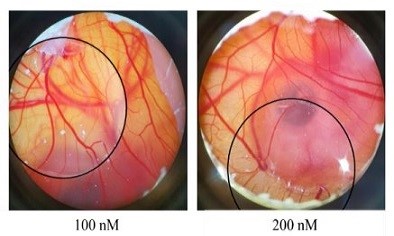Effects of neratinib on angiogenesis and the early stage of the embryo using chicken embryo as a model
DOI:
https://doi.org/10.17305/bb.2023.9869Keywords:
Neratinib, angiogenesis, embryogenesis, chorioallantoic membrane (CAM), tyrosine kinase inhibitor (TKI)Abstract
Angiogenesis is the process of forming new blood capillaries from pre-existing vessels. Even though it is essential during normal development, it plays a major role in cancer progression. Neratinib is a pan-human epidermal growth factor receptor (HER) inhibitor that has recently been approved for the treatment of HER2-positive breast cancer. However, its effects on angiogenesis and embryogenesis remain unknown. This study examined the antiangiogenic effects of neratinib using the chorioallantoic membrane (CAM) of chicken embryos. We also evaluated neratinib’s toxicity during the early stages of normal development using the chicken embryos, primary embryonic fibroblasts (EFBs), and human umbilical vein endothelial cells (HUVEC). Our findings revealed that neratinib significantly inhibited the CAM angiogenesis compared to controls by reducing vessel percentage area and the average vessel length. Furthermore, neratinib downregulated vascular endothelial growth factor (VEGF), a key mediator of angiogenesis. At lower concentrations, neratinib was well-tolerated during early stages of normal development. Additionally, EFBs treated with neratinib showed no morphological or viability changes when compared to controls. However, at the highest concentration tested, neratinib treatment reduced HUVEC cell viability. This effect may be associated with the dysregulation of key apoptotic genes, including caspase-3, caspase-8, caspase-9, and the B-cell lymphoma 2 (Bcl2) gene. Our findings indicate a novel potential application of neratinib as an antiangiogenic agent, exhibiting tolerable toxicity in the early stages of embryogenesis.
Citations
Downloads

Downloads
Published
License
Copyright (c) 2023 Hadeel Kheraldine, Arij Fouzat Hassan, Hashim Alhussein, Hamda Al-Thawadi, Semir Vranic, Ala-Eddin Al Moustafa

This work is licensed under a Creative Commons Attribution 4.0 International License.
How to Cite
Accepted 2023-11-17
Published 2024-05-02









